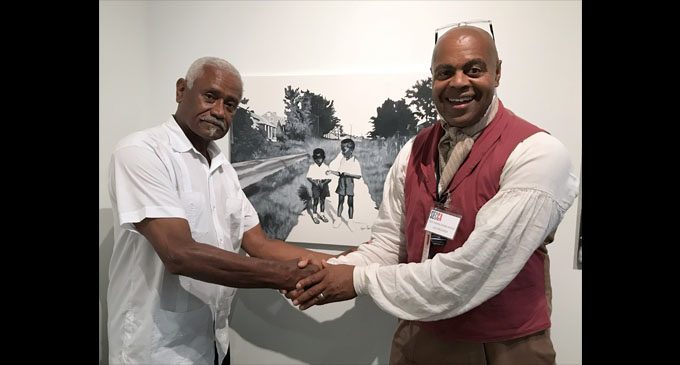Leo Rucker’s ‘Painting Happy Hill’ opens at SECCA
James McDuffie (on left) with Leo Rucker in front of the painting by Rucker from a photo of James and Melvin McDuffie as children on Liberia Street in Happy Hill.

By Judie Holcomb-Pack
Judging the success of an art opening is more than just the number of people who attend; it is also how enthusiastically they interact with the artist. Leo Rucker’s opening reception on Thursday, July 18, had both.
Attendees filled the gallery where his show, “Painting Happy Hill,” is displayed and friends surrounded Rucker like at a family reunion.
Indeed, for some it was a family reunion. James McDuffie, the subject of one of Rucker’s portraits, had numerous family members taking selfies with him and the portrait of him and his brother as children walking on Liberia Street. McDuffie said that in the photo from which Rucker painted the portrait, his brother was trying to get him to smile, but “I was being grumpy. We had been to church … you can tell because we were wearing our polished shoes.”
Rucker said he found about 300 photos that Mel White had collected when he worked at Old Salem. (Mel White was formerly the circulation manager at The Chronicle in the late 1980s). Rucker credits White for starting the Across the Creek project by collecting photos of Happy Hill and said the project evolved when he started reviewing the photos. “It was just waiting on the right opportunity,” Rucker explained.
To see the photos that Rucker painted from, to see not only the detail, but the emotion that he puts into each piece, is awe-inspiring. Portraits include Virgil Foy and Harriet Foy, called “We Happy;” Alice Simmons Pitts, “Ms. Alice;” Priscilla Walls McGee, “In Front of Ms. Mottie’s House;” Frank and Melvin McDuffie, “Shake On It;” John Forney, “The Stoneman;” and Spencer “Popeye” Anderson and Wilbert Burl, “Dan’s Place,” are just a few of the portraits that capture the heart and soul of this vibrant community.
Rucker credits the Arts Council of Winston-Salem and their support of public art for getting him started in his successful career as an artist. His love for art began at an early age and after receiving awards in high school, he attended Rutledge College, receiving a degree in commercial art. A competition at the Sawtooth Center for Visual Arts led to the first of many portraiture and mural commissions. He completed a series of drawings and paintings for the Forsyth County Partnership (Smart Start) and has done work for Segmented Marketing Services, including an ongoing column, Role Models, for Sophisticate’s Black Hair magazine that has featured more than 200 ethnic women from around the world.
Rucker has taught at the Sawtooth Center and presently works as the lead historic interpreter at Old Salem Museum and Gardens at the St. Philip’s African Moravian Heritage site. His show will be on display at SECCA through August 11. To learn more about Leo Rucker, visit www.ruckerartstudio.webs.com.
Also on display at SECCA is the exhibit, “Warm Water,” by Charles Edward Williams, a collection of re-narrated visual works based on the event that sparked the Chicago Race Riot of 1919. These works tell the story of five black teens and what reportedly caused the death of Eugene Williams in Lake Michigan on the South Side of Chicago.
On display through January 5 is the exhibit, “Furnished,” hanging in the main gallery. A juried exhibition, it features more than 50 works by 15 contemporary artists, from furniture-based sculpture to sculpture that functions as furniture.
SECCA is located at 750 Marguerite Drive and admission is free. For more information, visit www.secca.org.










